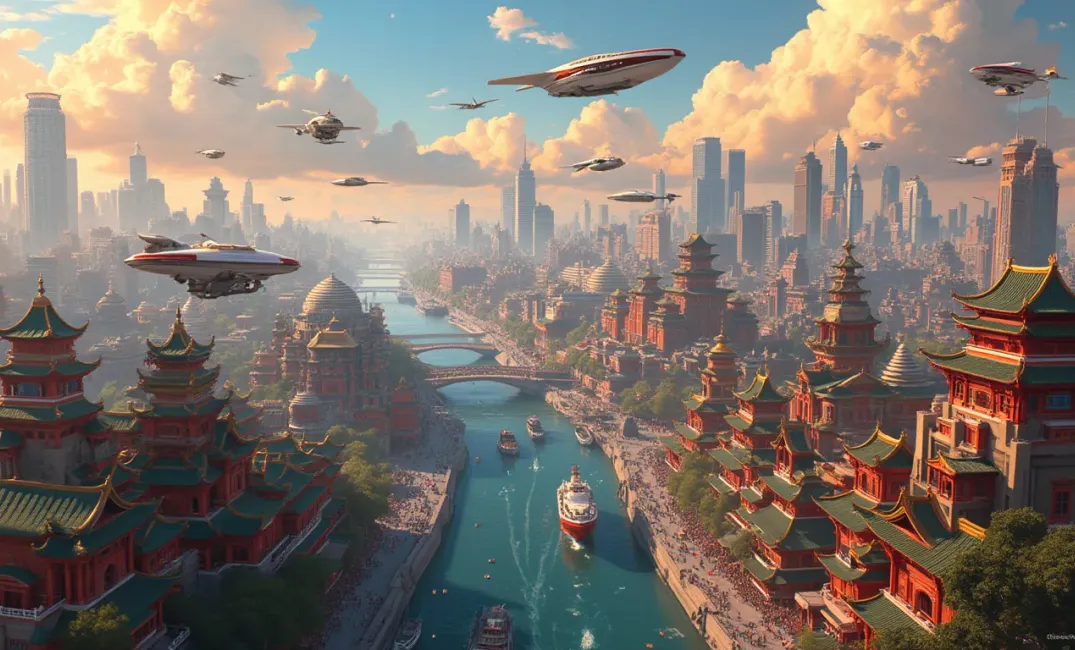Introduction: Transportation as a Catalyst for Civilization
Transportation embodies humanity's desire to connect, explore, and innovate. Throughout history, the evolution of transportation has catalyzed significant societal transformations, shaping economic, cultural, and technological landscapes. From the first steps of early humans to the potential of interstellar travel, this entry examines the profound impact of transportation on human development and the quest to journey beyond the possible.
"The journey of a thousand miles begins with one step." — Lao Tzu
Ancient Pathways: Walking, Riding, and Sailing
The First Steps: Human Locomotion and Migration
- Early Migrations: Human migration began with walking, as early humans traversed vast distances in pursuit of resources and hospitable climates. This spirit of exploration paved the way for cultural exchanges and the spread of knowledge across continents.
- On the Backs of Animals: The domestication of animals like horses, camels, and donkeys marked a significant leap in transportation. These animals enabled faster and more efficient travel, facilitating trade and communication across expanding territories.
Sailing the Seas: The Dawn of Maritime Exploration
- Primitive Watercraft: Simple watercraft, such as canoes and rafts, supported the earliest forays into maritime exploration. These vessels expanded human reach to islands and continental coastlines, marking the beginning of a maritime tradition.
- Seafaring Innovations: Ancient cultures, such as the Phoenicians, Egyptians, and Polynesians, mastered shipbuilding and navigation, adventuring beyond their shores. These advancements laid the groundwork for global exploration and exchanges.
Medieval and Renaissance Roads: Wheels, Carriages, and Exploration
The Age of Wheels: Harnessing Land Transport
- The Invention of the Wheel: The wheel’s invention drastically influenced land transport, enabling the creation of carts and chariots which improved mobility and goods transport efficiency. Societies like Mesopotamia and China integrated wheeled transport into their economies.
- Carriages and Stagecoaches: By the Medieval period, carriages evolved to accommodate passengers, facilitating social mobility and commerce. Europe's stagecoach networks allowed for standardized travel routes, helping to unify and expand burgeoning trade systems.
Navigational Mastery: Charting New World Directions
- The Compass and Astrolabe: Navigational tools like the compass and astrolabe empowered sailors to venture further into unknown waters. These innovations were instrumental during the Age of Exploration, guiding explorers like Columbus and Magellan on historic voyages.
- Renaissance Shipbuilding: Harbors teemed with galleons and caravels outfitted with sails designed to harness wind more effectively, signaling a new era of cultural exchange and colonization that reshaped global dynamics.
The Industrial Revolution: Engines of Progress and the Modern Age
Steam Power and the Iron Rails
- The Locomotive Revolution: The advent of the steam engine ignited the locomotive revolution, forever transforming land transport. Railways connected distant cities and industries, accelerating commerce and migration while reducing travel time dramatically.
- Impact of Rail Networks: Rail networks facilitated regional integration, economic growth, and urbanization. By bridging urban and rural divides, railways were pivotal in modernizing societies and spurring industrial proliferation.
Oceanic Connectivity: The Steamship Era
- The Age of Steamships: Steamships revolutionized maritime transport, making long-distance sea travel faster and more reliable. Passengers and cargo traversing oceans benefited from expanded routes, shaping immigration patterns and global trade.
- Laying Communication Lines: Undersea telegraph cables were laid alongside steamship routes, knitting continents together with near-instant communication, crucial to managing empires and forging global links.
The 20th Century and Beyond: Flight and Cosmic Aspirations
The Wright Brothers and Aviation Innovation
- First Powered Flight: The Wright Brothers’ successful powered flight in 1903 heralded the aviation age. Aircraft swiftly developed, shrinking the world by enabling rapid cross-continental travel.
- Commercial Aviation: The post-war expansion of airlines democratized air travel, creating a global village where cultures and economies interwove amidst a network of flight paths.
Space Exploration: Crossing the Final Frontier
- Rocket Technology: Developments in rocketry, bolstered by innovators like Tsiolkovsky and Von Braun, made space exploration conceivable. The Space Age dawned with accomplishments like the Apollo moon landing, embodying humanity’s cosmic aspirations.
- International Collaboration: Collective efforts such as the International Space Station exemplify how space exploration fosters multinational cooperation, encouraging peaceful pursuits toward new frontiers.
Future Horizons: Sustainable Mobility and Interstellar Possibilities
Embracing Sustainability in Transportation
- Electric and Hybrid Technologies: Modern transportation faces challenges related to sustainability and environmental impact. Electric and hybrid vehicles offer greener alternatives, reducing carbon footprints and reliance on fossil fuels.
- Public Transport Innovations: Advances in public transport, including high-speed trains and autonomous vehicles, prioritize sustainable design and energy efficiency, aiming to meet the demands of urban populations with minimal ecological disruption.
Charting Cosmic Courses: Dreams of Interstellar Travel
- The Warp and Folding Space: Concepts such as warp drives and space-time manipulation tantalize the imagination, suggesting future possibilities of interstellar travel that could redefine civilization.
- Colonizing New Worlds: Enthusiasm for Mars colonization and beyond reflects humanity’s established penchant for exploration and discovery, preparing for life on other planets through research in astrobiology, terraforming, and long-duration space travel.
Conclusion: Transportation’s Enduring Legacy
Transportation’s evolution—driven by humankind’s relentless ambitions and inventiveness—has fundamentally shaped civilizations, economies, and cultural landscapes. It embodies the journey from humble beginnings to those tantalizing vistas across the stars.
"Man is by nature a social animal, an indivisible being for whom transportation has bridged separations and laid foundations for shared futures." — Anonymous Traveler
As new technologies breathe life into visionary concepts, the saga of transportation continues to sketch pathways of unlimited imagination. It exemplifies humanity's desire to connect across distances, navigate uncharted territories, and endlessly reach for the horizon—imbuing the adventure of travel with both ancient wisdom and futuristic dreams. Through paths illuminated by technology and powered by human spirit, transportation remains a crucial artery sustaining and nourishing society's heartbeat.
AVIATION, MARITIME, SUSTAINABILITY, HISTORY, TECHNOLOGY, INNOVATION, TRAVEL, EXPLORATION, TRANSPORTATION

